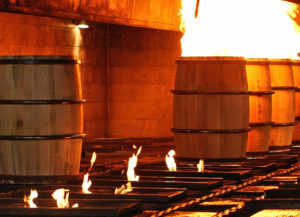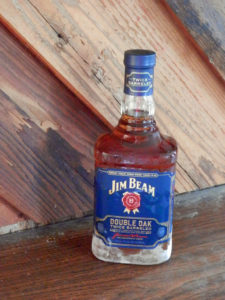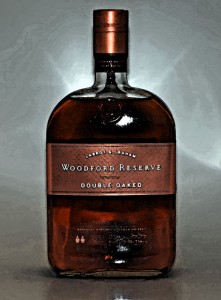What You Need To Know About Twice, New Barreled Bourbon
By Richard Thomas
Earlier this year, Jim Beam released their new Double Oak Bourbon, and in doing so made the third major addition to a growing category of bourbon whiskey: twice new barreled. If you like your whiskey to have plenty of wood spices and sweetness without actually being oaky, this is a good thing, because that is exactly what raising the stake in new oak accomplishes.
Toasting And Charring
Step into the whiskey aisle of any liquor store, and depending on who made them, the bourbons on the shelf have acquired 50 to 80% of their flavor from being matured in new white oak barrels. A major element in what flavors the whiskey draws out of the wood during maturation is how heavily charred the interior of the barrel is, because putting the wood to the torch carmelizes the wood sugars, mellows tannins and other compounds in the wood, and creates purifying charcoal.
At the cooperage, the heat can be dialed from a mild toast up to a heavy char to tweak those flavors, and the char level can be a signature element in a distillery’s particular production process. Wild Turkey fans, to cite one example, wax about Jimmy Russell’s preference for the #4 “alligator” char, the deepest charring commonly found in the industry (although deeper chars are possible, and sometimes used on a limited basis).
Here we come to the question: after maturing bourbon in one set of charred, new oak barrels, what about doubling down and do it twice? Finishing in a second set of casks was a concept developed in Scotland, but it usually relies on old barrels previously used to age sherry, rum, port, madeira or some other type of alcohol. Grabbing a new set of barrels for a second round of aging lasting several months to a year was not unheard of, but is hardly the norm, yet it is now becoming a growing category in American bourbon.
Two Barrel Bourbon
The first American foray into going twice with new oak was made by Prichard’s Distillery in Tennessee, a small distillery that opened its doors in the late 1990s, several years before even the earliest entrants of the craft whiskey boom. In 2002, they released their Double Barreled Bourbon as a limited offering.
The first major, sustained release in the category followed a decade later, when Woodford Reserve unveiled its Woodford Reserve Double Oaked in 2012. This bourbon differed from Prichard’s in using a specially prepared barrel that was first deeply toasted and then only lightly charred, rather than using a more regular barrel. This added more oak character while softening it at the same time.
It took a couple of years before more new barrel-finished bourbon appeared. In 2014, Michter’s joined Woodford Reserve by releasing it’s similar Toasted Barrel Bourbon, with the crucial difference that the Michter’s expression is a limited edition and a new batch is not necessarily released every year.
That year also saw the release of another double barrel limited release from Abraham Smith Bowman in Virginia. Like Prichard’s, this release was twice-aged in a more regular set of new barrels, rather than the specially prepared, toasted barrels used by Woodford and Michter’s for their second go-around.
In 2015, Woodford Reserve upped the ante on their Double Oak by releasing Double Double Oaked as a distillery-only limited release, this expression being essentially Double Oak with an extra year of finishing in the toasted barrels.
Now Jim Beam has entered the picture, putting out a product that is made in a process similar to that of the Prichard’s and Bowman bourbons, that is aging a second set of normal-but-otherwise-new bourbon barrels. However, it is also like Woodford Double Oaked in being a bourbon in regular release, one that you can count on seeing widely and reliably on store shelves. With two such bourbons in regular release and one in semi-regular status, we can now think of double, new barrel bourbon as a real “thing.”
 The Whiskey Reviewer A World of Whiskey, Poured Every Weekday
The Whiskey Reviewer A World of Whiskey, Poured Every Weekday



